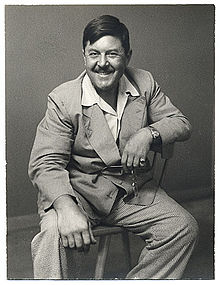Philip Evergood
| Philip Evergood | |
|---|---|

Philip Evergood, circa 1942
|
|
| Born |
Philip Howard Francis Dixon Blakshi 1901 New York City |
| Died | 1973 Bridgewater, Connecticut |
| Nationality | American |
| Known for | Painting, Sculpture, Printmaking |
Philip Howard Francis Dixon Evergood (born Howard Blashki; 1901–1973) was a Jewish American painter, etcher, lithographer, sculptor, illustrator and writer. He was particularly active during the Depression and World War II era.
Philip Evergood was born in New York City. His mother was English and his father, Miles Evergood, was an Australian artist of Polish Jewish descent who, in 1915, changed the family's name from Blashki to Evergood. Philip Evergood's formal education began in 1905. He studied music and by 1908 he was playing the piano in a concert with his teacher.
He attended different English boarding schools starting in 1909 and was educated mainly at Eton and Cambridge University. In 1921 he decided to study art, left Cambridge, and went to London to study with Henry Tonks at the Slade School.
In 1923 Evergood went back to New York where he studied at the Art Students League of New York for a year. He then returned to Europe, worked at various jobs in Paris, painted independently, and studied at the Académie Julian, both with André Lhote and with Stanley William Hayter; Hayter taught him engraving.
He returned to New York in 1926 and began a career that was marked by the hardships of severe illness, an almost fatal operation, and constant financial trouble.
It was not until the collector Joseph H. Hirshhorn purchased several of his paintings that he could consider his financial troubles over. Evergood worked on WPA art projects from 1934 to 1937 where he painted two murals: The Story of Richmond Hill (1936–37, Public Library branch, Queens, N.Y.) and 'Cotton from Field to Mill (1938, post office in Jackson, Ga.). He taught both music and art as late as 1943, and finally moved to Southbury, Connecticut, in 1952. He was a full member of the Art Students League of New York and the National Institute of Arts and Letters. He was killed in a house fire in Bridgewater, Connecticut, in 1973 at the age of 72. He is buried in Green-Wood Cemetery, Brooklyn.
...
Wikipedia
